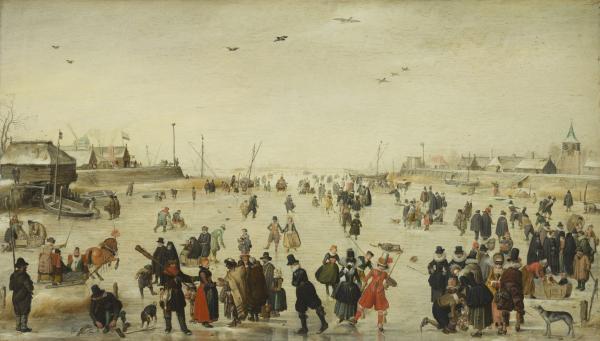One day, while exploring our galleries, I found myself drawn to our busy but vibrant Avercamp. Hendrick Avercamp (1585–1634) was a Dutch painter known for his winter landscapes as well as his paintings of skating. Winter Scene on a Frozen Canal gives us a glimpse of the lives of myriad characters enjoying a day of leisure on the ice. The figures in Avercamp’s painting subsume a wide range of identities that existed in the Netherlands at that time; one can see the rich and the poor, people of many different religious affiliations, and most noticeably a group of figures at the front of the composition that seems to belong in a different world.
.jpg)
I had never noticed them before, but suddenly I couldn’t take my eyes off them. They are a group of five—two adult women and three small children whose dress, appearance, and actions stand in stark contrast to all the other figures. While everyone else on the ice is spending their day leisurely, these people are at work, reading the palms of some of the wealthier women. Both of the women wear large, tattered cloaks that cover a patchwork of clothing that look nothing like the bodices and petticoats the other women wear. Also, in a sea of blondes, redheads, and brunettes, everyone in this group has a head of curly black hair. However, the difference that stood out the most to me was their skin; although most of the people in the scene have fair complexion, the people in the group have dark brown skin.
How did I not notice these people before? And, more importantly, who were these individuals? Almost immediately, I was stumped. I couldn’t find any reference to these figures in any of the sources that discuss the painting, and I couldn’t find any information about them in our files. It was only when I scoured the record for all of Avercamp’s paintings and studies that I had my eureka moment. One of Avercamp’s drawings, Ziegeuner am Lagerfeuer (Gypsies by the Campfire), featured a large group of figures that looked exactly like my mystery characters. From there, more historical evidence helped me to confirm their Romani identity. (The term "Gypsy," while a historical term, is deemed to be a racial slur used to discriminate against an ethnic minority throughout Europe and the United States. Thus, in this discussion I will be using the word "Romani," which is how members of this ethnic group refer to themselves.)
What were the lives of the Romani at the time of Avercamp’s painting? The Romani first appeared in the Netherlands in the 15th century and were accepted within Netherlandish society until the 16th century, when they began to be persecuted by some communities. At the time of the creation of Winter Scene on a Frozen Canal, Romani people were banned in some Dutch communities. This prejudice became worse as the Dutch government enacted an order that called for the kill and capture of the remaining Romani population in the 18th century. As a result, Romani communities fled from the Netherlands for their safety and did not return until the 1860s.
.jpg)
I was fascinated by how Avercamp presented the Romani in this scene and how he contrasted them against the rest of the characters in the composition. Avercamp signals to the audience that they are a societal other, not just in their dress and appearance, but also by how others in the scene treat them. As the Romani women read the palms of Dutch women, their families appear to be cautiously watching them, indicating that this interaction is causing them to be wary. Avercamp visually establishes not only the social milieu of Dutch society in the early 17th century, but also the societal boundaries of who is an insider and who is an outsider within that society. Winter Scene on a Frozen Canal reminds us how art can be used as a tool to create and codify these ideas.
View Hendrick Avercamp’s Winter Scene on a Frozen Canal in the Ahmanson Building, Level 3.



